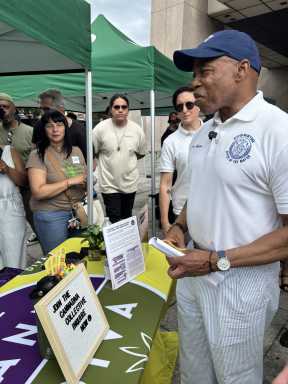Adams Touts Harlem as Cannabis Capital, but Red Tape Still Rules the Boroughs

As New York City aims to position itself as the nation’s “cannabis capital,” familiar bureaucratic tangles and equity ambitions shape the odds of actually reaping the rewards.
On a sticky Saturday in Harlem, Mayor Eric Adams stood under the shadow of the Adam Clayton Powell Jr. State Office Building and cast a bold vision: “We want to make sure that New York becomes the cannabis capital of the globe.” This pronouncement, delivered before more than a hundred would-be entrepreneurs and enthusiasts at the city’s inaugural Cannabis Festival and Resource Fair, marked a brass-tacks acknowledgment of both how far the city has come in legalising cannabis—and how far it has left to go.
Mr Adams’s pitch for a greener, more permissive future follows a flurry of activity: authorities have shuttered over 1,400 illegal cannabis outlets citywide while a mere 175 legal dispensaries have sprouted from heavy-handed soil. Statewide, the total stands at 433. Adams wants to transfer momentum from shadowy street-corner sellers to taxpaying storefronts—preferably with a bit less regulatory mulch.
The festival—a cross between a job fair and what bureaucrats might call a “stakeholder engagement event”—came not a moment too soon. New Yorkers, particularly Black and Hispanic residents, have endured the rougher edge of cannabis prohibition for decades. The administration, keen to address these “disproportionate impacts,” insists that equity is not mere window dressing. Dynishal Gross, Commissioner of the Department of Small Business Services, deemed the event a “historic moment” for a famously recalcitrant city bureaucracy.
But progress remains painfully uneven. Legal hurdles abound: court injunctions have frozen the approval of many would-be licensees, and the state’s new Office of Cannabis Management, recently expanded from 170 to 250 staff, is scrambling to review a backlog of applications from last November and December. Even where regulations are clear, entrepreneurs find them thicketed with procedural brambles.
Such bureaucracy is not merely a nuisance—it can be ruinous. Jessica Naissant, CEO of Renaissañt NYC, the first Haitian-American-owned dispensary in the state, recounted how it took her two and a half years to move from signature to sale, enduring everything from interminable forms and dodgy investors to repeated brushes with police. “It drained my savings,” she said. Many would-be merchants, particularly those with less capital, are simply left on the sidelines.
The city’s balancing act—between nipping illegal sales and not suffocating the legal market—has economic teeth. Legal dispensaries theoretically offer the city fresh revenue streams: New York’s cannabis tax regime bodes to net hundreds of millions once markets mature. Yet, the gulf between ambition and reality is visible. For now, the illegal market remains far from extinguished and, in some boroughs, remains dominant.
The political calculus is equally fraught. Messaging around equity is central, especially in communities like Harlem most affected by both overpolicing and failed prohibition. Ensuring that Black and brown New Yorkers do more than window-dress for progress is crucial—hence the rhetoric and appointments in the state’s cannabis bureaucracy of “chief equity officers.” Success stories like Ms Naissant’s are still rare enough to feel more exception than rule.
The implications extend beyond tax receipts and social justice bonhomie. The medical cannabis market is now billed as a “huge thing for New Yorkers.” Advocates worry, with some justification, that a tepid rollout of adult-use businesses will limit access for medical users, whose needs—for products, for experienced retailers—differ sharply from the recreational crowd. For city health authorities and law enforcement, the patchwork status quo risks undermining both public health goals and community trust.
Legal thickets and green shoots: How NYC compares
A glance at other American states puts New York’s experience into worrying context. California’s legal market, five years on, remains dwarfed by illicit suppliers; New York’s startup pains—lengthy licensing delays, high taxes, overlapping local and state mandates—echo that unhappy West Coast history. Colorado and Massachusetts, meanwhile, have achieved more stable markets by front-loading regulatory clarity and investing early in business support and technical assistance.
Globally, New York’s self-styled “capital” ambitions may prove overzealous. Legal cannabis rollout in Canada, for instance, has moved more swiftly despite national coordination challenges; Dutch cities have quietly regulated cannabis cafes for decades. New York’s penchant for legal caution and political symbolism threatens to leave its market both undergrown and over-governed.
Still, the city has a few robust assets on its side. It boasts an unmatched retail savvy, a dense consumer base, and a storied tradition of absorbing newcomers (and new industries). The Adams administration’s willingness to publicise and convene—however performatively—cannot hurt. And New York’s brand, not least with tourists, portends buoyant demand, if only the supply lines were clear.
But as ever in Gotham, results will come not from rhetoric but from regulatory finesse. The history of local business development is littered with best-laid plans for “hub” status—in tech, in green jobs, in finance—many of which have succumbed to what one city wag once called “death by a thousand community-board meetings.” If the goal is to outpace the illegal market and ensure equity, New York’s efforts will have to be more nimble and less prone to paltry legal entanglements.
For now, though, New York’s cannabis aspirations remain more slogan than substance. Removing needless hurdles, getting tax and zoning regimes right, and continuing to seed opportunities for communities historically left out are prerequisites for reaping a truly broad harvest. Until then, the city’s quest for the cannabis crown threatens to become another case of high hopes meeting the granite reality of municipal process.
New Yorkers, ever ingenious, can no doubt build a vibrant cannabis sector. But a capital, in the economic sense, requires both leadership and letting go—less fanfare, more follow-through. Time will tell whether the Adams administration and its partners can clear the haze. ■
Based on reporting from amNewYork; additional analysis and context by Borough Brief.